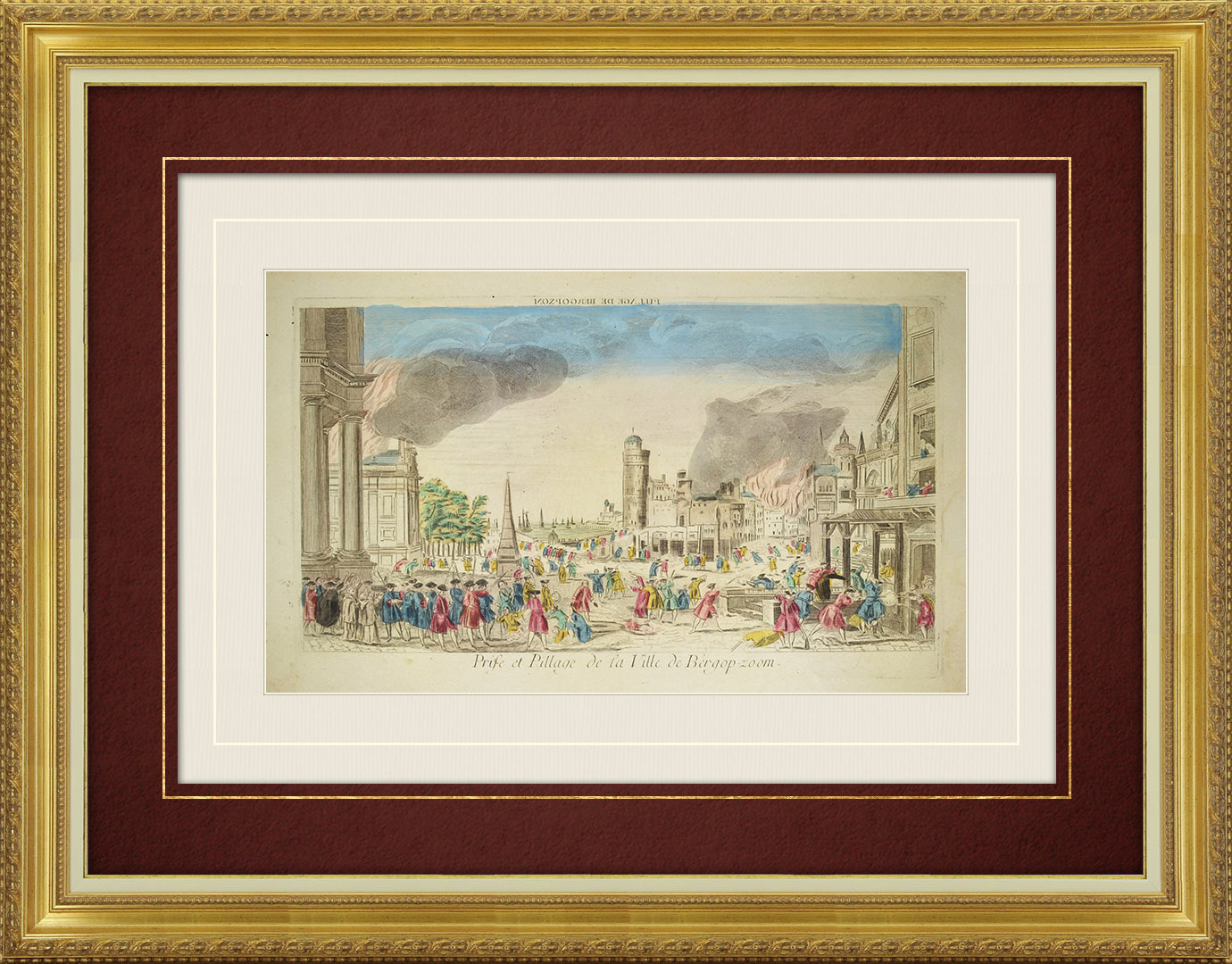
Original title
Prise et Pillage de la Ville de Bergop-zoom
Description
XVIIIth century optical view in original watercolors. Original copper plate engraving on laid paper with watermark heightened with watercolor at that time. Circa 1750, depicting a view of the Storming and Sacking of Bergen op Zoom in 1747 (Holland).
During the 18th Century, several renowned establishments in Paris, London (England), Augsburg (Germany) and Bassano (Italy) were specialized in the creation of these optical views. They could be viewed alone or through a zograscope, a wooden foot surmounted by a lens which enlarged the image and accentuated the perspective effect. They could also be placed in optical boxes, the spectator then looked inside the box through the lens. This distraction was greatly appreciated in the 18th Century in the salons of the bourgeoisie and the nobility as in the countryside thanks to the hawkers.
These etchings are nowadays exhibited in museums around the world and extremely appreciated by collectors and decorators for their historical interest and their high decorative value.
Museums & Archives
The Bibliothèque nationale de France owns a copy of this optical view in its collections. For more details on this print please consult the site : Prise et pillage de la ville de bergop-zoom
Find more artworks related to these topics :
This strong water etching is listed in these categories :
Bergen op Zoom was granted city status in 1212. In 1287 the city and its surroundings became a lordship as it was separated from the lordship of Breda. The lordship was elevated to a margraviate in 1559. Several noble families, including the House of Glymes, ruled Bergen op Zoom in succession until 1795, although the title was only nominal since at least the seventeenth century.
During the early modern period, Bergen op Zoom was a very strong fortress and one of the main armories and arsenals of the United Provinces. It had a remarkable natural defensive site, surrounded as it was by marshes and easily flooded polders. Furthermore, it could receive reinforcements and supplies by sea, if the besieging army did not have a fleet to blockade its port.
Due to these features, the city was one of the strategic points held by the Dutch during their revolt in the Eighty Years War, beginning in the late sixteenth century. It was at that time besieged by Alessandro Farnese first in 1588, and by Ambrosio Spinola a second time in 1622. Both sieges were unsuccessful, and Bergen op Zoom got the nickname La Pucelle or The Virgin as it was never successfully taken in a siege.
In 1747, during the War of the Austrian Succession, the French army laid siege to the city. Bergen op Zoom had been fortified by new works built in the beginning of the 17th century by Menno van Coehoorn, with three forts surrounding the city and a canalized diversion of the Scheldt acting as a ditch around its walls. However, it had no second line of fortifications, nor any fortress. After seventy days of siege, the city was taken and thoroughly sacked; the garrison was slaughtered.
The Galerie Napoléon is pleased to propose to you this strong water etching printed 274 years ago (around 1750).
As for all the antique prints in our catalogue, this optical view Prise et Pillage de la Ville de Bergop-zoom datant de 1750 is dispatched worldwide within 24H in a Secured packaging, accompanied by its certificate of authenticity guaranteeing the name of the artists (draughtsman, engraver, editor), the impression process used (Strong water) and its date (1750).
In order to guarantee a perfect conservation in time, this strong water etching is dispatched, ready to be framed, under museum quality color passepartout (manufactured without acid in the pulp for a neutral pH) on a cream mountboard made from carton bois (also acid free & neutral pH), in a luxurious portfolio.
At the apogee of the mode for optical views, between 1750 and 1790, four European cities specialized in their edition: Paris (France), London (England), Augsburg (Germany) and Bassano (Italy).
Optical views are prized in very different social circles : pleasant recreation in aristocratic salons, the views are admired in beautiful and richly decorated optical boxes which are real works of art. The show was transformed into a real scientific experiment. But the optical views also entertained the people who were in a hurry when a hawker set up a box on a market and began to narrate the extraordinary events that had taken place in a more or less distant and inaccessible country.
There are three categories in the production of optical views.

With more than 20 years experience and a catalogue of more than 40.000 antique prints, drawings and historical documents dating from the 14th to the 19th century, the Galerie Napoléon, parisian antique dealer's gallery, is one of the world references in the field of antique prints,etchings and antique graphic arts.
In addition to thousands of impassioned of antique prints throughout the world, the Galerie Napoléon is honoured to count among its customers : national archives, museums, historical monuments and important home designer companies. All attracted by the extraordinary diversity of its catalogue and the quality and speed of its services.
This experience allows us to guarantee to each one of our customers the authenticity of the antiques in our catalogue and the shipment of their orders within 24 hours.

Customize for free the color of your museum quality bevel cut edge passepartout (acid free & neutral pH) among a color chart of 23 shades.
This option will be offered to you free of charge in the cart.
All our antiques can be shipped worldwide. The orders are dispatched within 24H in a secured packaging.
The Galerie Napoléon offers free shipping for all orders over 50EUR for France, 70EUR for all EU destinations and 90EUR for worldwide destinations.
For orders below these amounts, the shipping costs are 8EUR for France, 12EUR for all EU destinations and 17EUR for worldwide destinations.
















